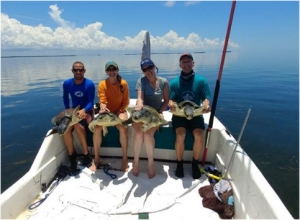Grant: 17-045R
Project Title: Long-Term Monitoring Of Sea Turtles In Florida’s Big Bend
Project Manager: Jonathan Gorham
Organization: Inwater Research Group (Non-Profit Organization)
Grant Amount: $17,040.00
Completion Date: 2018-06-04
Summary: The shallow seagrass habitat of the Big Bend region serves as important developmental habitat for green, Kemp’s ridley, and loggerhead sea turtles. While the region has historically high capture rates and extensive sea turtle habitat, it lacked active sea turtle monitoring projects. In 2012, Inwater Research Group (IRG) began a long-term in-water study of sea turtles in the Big Bend in the waters near Crystal River. To date the project has captured 117 green turtles, 119 Kemp’s ridleys, and 7 loggerheads. Visual surveys of the area have estimated sea turtle densities of more than 100 turtles per square kilometer in some locations. The high density of turtles across multiple species makes this study an excellent location to monitor long term trends in species composition, abundance, size distribution, sex ratios, and disease prevalence. IRG’s ability to safely and efficiently capture sea turtles at the Crystal River site has also given other researchers an opportunity to collect samples for their work. In past years collaborators have collected samples to study fibropapillomatosis, effects of red tide exposure, green turtle health parameters, and stable isotope analysis. We expect these collaborations will continue during the 2017 field season. In 2016, IRG discovered a portion of our study area that contains large subadult green turtles. The straight carapace length of these turtles was 15 cm larger and they were more than double the weight of any of the other previously captured green turtles in the study area. They were also larger than any green turtle caught in any of the previous in-water projects in the region. Preliminary visual surveys in the area recorded numerous subadult green turtles similar to the ones captured. This suggests the presence of a subadult green turtle foraging aggregation, potentially making this only the second in the southeastern United States.  Results: Initial results suggest that subadult (mean depth = 1.74 ± 0.5 m) and adult (mean depth = 1.59 ± 0.47 m) loggerheads preferred medium depths and were distributed across the study area. Juvenile (mean depth = 1.35 ± 0.46 m) green turtles preferred shallow waters whereas subadults (mean depth = 2.07 ± 0.43 m) were most commonly found in deep waters (Figure 3B) at the southern edge of the study site. Juvenile (mean depth = 1.17 ± 0.19 m) and subadult (mean depth = 1.22 ± 0.36 m) Kemp’s ridleys were observed only in the shallow waters and were absent in deep waters found at the southern edge of the study site.
Results: Initial results suggest that subadult (mean depth = 1.74 ± 0.5 m) and adult (mean depth = 1.59 ± 0.47 m) loggerheads preferred medium depths and were distributed across the study area. Juvenile (mean depth = 1.35 ± 0.46 m) green turtles preferred shallow waters whereas subadults (mean depth = 2.07 ± 0.43 m) were most commonly found in deep waters (Figure 3B) at the southern edge of the study site. Juvenile (mean depth = 1.17 ± 0.19 m) and subadult (mean depth = 1.22 ± 0.36 m) Kemp’s ridleys were observed only in the shallow waters and were absent in deep waters found at the southern edge of the study site.